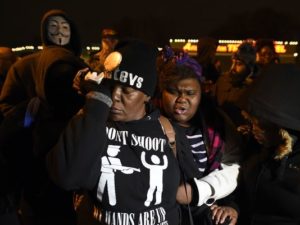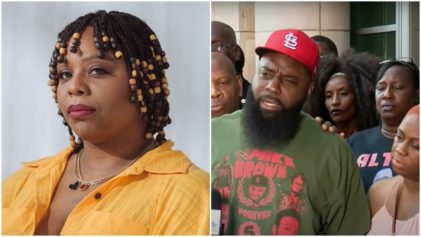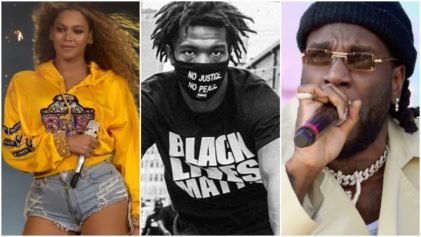
But although leadership from President Obama down to local officials pleaded for calm, the Black community’s expression of anger at the illegitimacy of the political and social systems that control their lives was directly in line with the types of revolts and protestations Black people have shown throughout American history—not to mention political revolts in other parts of the world, according to history experts.
“When Black people have struggled for freedom, citizenship, it has taken multiple forms: lobbying, political activity, exercising the vote, civil disobedience—and also open rebellion, which is what we’re seeing now. The idea that there’s only one form that Black politics and political action can take does not square with the history of struggle,” Clarence Lang, associate professor of African and African-American Studies at the University of Kansas, told Atlanta Blackstar. “Black people in Ferguson are not doing anything different than what has happened in historical movements. That doesn’t mean I savor that response. But if we say there’s only one way to protest, that’s not been the case for anyone’s history—certainly not for Black history.”
“Even in slavery,” he continued, “the protests included lobbying and moral suasion—but there were also slave revolts.”
Lang, a former resident of the St. Louis metropolitan area, is an expert on the history of Black activism in St. Louis. He explored the issue in his latest book, “Grassroots at the Gateway: Class Politics and Black Freedom Struggle in St. Louis, 1936-75.”
“The way they’re framing the protest there, in terms of crime, destruction and lawlessness, allows us to avoid taking seriously the political issues people are raising—around the relationship of Black people and the police, around racial profiling, around issues of racial and economic inequality,” he said. “It takes grievances that are real and minimizes it as crime.”
It is a predictable American response to Black political protest—turn legitimate grievance into criminal activity by “thugs.” Ironically, as Lang points out, if the same sort of protest was occurring in Central America or northern Africa or central Europe, it would be immediately recognized by the American media as a manifestation of political and civil dissension in the aftermath of a questionable political act by the government.
“We have a severe crisis of the legitimacy of our governing and legal institutions,” Lang said. “Black people do not feel safe in their communities. That’s the irony. They don’t feel that the institutions that exist to represent them are protecting them and serving their interests. In that absence, people are engaging in vandalizing and looting. What people are feeling is very little public empathy for Black rights and well-being. People are responding to that. We see all the riot police with their gear and smoke bombs and vehicles—you can put a million of them on the street, but the issue will not be resolved. They will restore order, but they will not restore legitimacy. Legitimacy will be restored when people feel the institutions that provide law and justice will provide law and justice for them. The system’s response has been to restore order through force, but there won’t be peace.”
Ranging from the armed self-defense of the Black Panthers to the nonviolent resistance of the Civil Rights Movement, the methods of Black freedom fighters have been varied and sophisticated. And while the Civil Rights Movement relied heavily on nonviolent protest methods that Martin Luther King adapted from Mahatma Gandhi (with some tutoring from leaders such as Bayard Rustin), even within that movement there were lieutenants like James Forman, head of the Student Nonviolent Coordinating Committee, who couldn’t completely purge their souls of the instinct to respond to injustice with violent aggression. When the authorities in Alabama refused to accede to the movement’s wishes during the Selma-to-Montgomery marches, Forman famously warned, “If we can’t sit at the table of democracy, we’ll knock the f*cking legs off!”
In essence, that’s what we have been witnessing with the Ferguson rage—an attempt to knock the legs off.
“Across time people of color have always responded with protest. You can take it back to the 18th century in South Carolina, to Haiti— scholars are now even discussing how enslaved people participated in their own emancipation,” Sharony Green, assistant professor of American History at the University of Alabama, told Atlanta Blackstar.
In fact, there’s a significant element in Black resistance in the 1960’s that actually focused on armed self-defense, as Lang discussed in a 2007 essay in The Journal of African American History that he wrote with the University of Illinois’ Sundiata Cha-Jua.
“Armed self-defense has been a common tactic throughout African American history,” they wrote.
Throughout the 20th century, there were frequent explosions of Black anger, usually in response to the ugly murder of an African-American—often committed by the police. Cities like Atlanta, Philadelphia, East St. Louis, and Springfield, Illinois, exploded in deadly race riots usually triggered by some horrific act committed by a white police officer.
Lang said that alongside the rowdier elements who created havoc in Ferguson are groups of Black activists who have been engaged in the mundane, day-to-day organizing that builds institutions and expands their base of supports.
“I don’t want to reduce the response to rioting,” he said. “There are people there engaged in multiple activities. But at the same time, I’m not quick to dismiss the disturbances as Black people just being lawless either. That activity they are engaged in is all part of the spectrum of activism, the spectrum of struggle. If we don’t want to see people in the streets, we have to figure out how they can feel the justice system will work for them and not simply upon them.”
Lang said he has been intrigued by the outbursts in Ferguson following Brown’s murder and the grand jury decision not to indict Wilson because they do differ from St. Louis’s form of activism in the 1960’s and 1970’s. When communities like Newark and Detroit were up in flames, St. Louis was able to keep a lid on that sort of violent, angry aggression.
“The way racism was enacted there was through civility, interracial civility,” Lang said. “The white elites were able to manage race relations through dialogue and committees, involving a stratum of Black leaders who agreed to act within certain boundaries, such as responsibility and civility. What’s interesting about Ferguson now is that the people on the ground are flipping the script. What they are doing now flies in the face of the long history of struggle in that area.”


